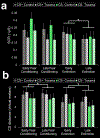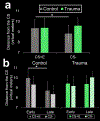Alterations in fear extinction neural circuitry and fear-related behavior linked to trauma exposure in children
- PMID: 33069739
- PMCID: PMC7722124
- DOI: 10.1016/j.bbr.2020.112958
Alterations in fear extinction neural circuitry and fear-related behavior linked to trauma exposure in children
Abstract
Exposure to childhood trauma is extremely common (>60 %) and is a leading risk factor for fear-based disorders, including anxiety and posttraumatic stress disorder. These disorders are characterized by deficits in fear extinction and dysfunction in underlying neural circuitry. Given the strong and pervasive link between childhood trauma and the development of psychopathology, fear extinction may be a key mechanism. The present study tests the impact of childhood trauma exposure on fear extinction and underlying neural circuitry. Children (N = 44, 45 % trauma-exposed; 6-11 yrs) completed a novel two-day virtual reality fear extinction experiment. On day one, participants underwent fear conditioning and extinction. Twenty-four hours later, participants completed a test of extinction recall during fMRI. Conditioned fear was measured throughout the experiment using skin conductance and fear-related behavior, and activation in fear-related brain regions was estimated during recall. There were no group differences in conditioned fear during fear conditioning or extinction learning. During extinction recall, however, trauma-exposed children kept more distance from both the previously extinguished and the safety cue, suggesting poor differentiation between threat and safety cues. Trauma-exposed youth also failed to approach the previously extinguished cue over the course of extinction recall. The effects on fear-related behavior during extinction recall were accompanied by higher activation to the previously extinguished cue in fear-relevant brain regions, including the dorsal anterior cingulate cortex and anterior insula, in trauma-exposed relative to control children. Alterations in fear-related brain regions and fear-related behavior may be a core mechanism through which childhood trauma confers heightened vulnerability to psychopathology.
Keywords: Childhood adversity; Childhood trauma; Extinction recall; Fear conditioning; fMRI.
Copyright © 2020 Elsevier B.V. All rights reserved.
Figures




Similar articles
-
Poor between-session recall of extinction learning and hippocampal activation and connectivity in children.Neurobiol Learn Mem. 2018 Dec;156:86-95. doi: 10.1016/j.nlm.2018.10.007. Epub 2018 Oct 19. Neurobiol Learn Mem. 2018. PMID: 30347237 Free PMC article.
-
Association of Resting Metabolism in the Fear Neural Network With Extinction Recall Activations and Clinical Measures in Trauma-Exposed Individuals.Am J Psychiatry. 2016 Sep 1;173(9):930-8. doi: 10.1176/appi.ajp.2015.14111460. Epub 2016 Feb 26. Am J Psychiatry. 2016. PMID: 26917165
-
Deficient fear extinction memory in posttraumatic stress disorder.Neurobiol Learn Mem. 2016 Dec;136:116-126. doi: 10.1016/j.nlm.2016.09.016. Epub 2016 Sep 26. Neurobiol Learn Mem. 2016. PMID: 27686278
-
Fear extinction in the human brain: A meta-analysis of fMRI studies in healthy participants.Neurosci Biobehav Rev. 2018 May;88:16-25. doi: 10.1016/j.neubiorev.2018.03.002. Epub 2018 Mar 10. Neurosci Biobehav Rev. 2018. PMID: 29530516 Review.
-
From Pavlov to PTSD: the extinction of conditioned fear in rodents, humans, and anxiety disorders.Neurobiol Learn Mem. 2014 Sep;113:3-18. doi: 10.1016/j.nlm.2013.11.014. Epub 2013 Dec 7. Neurobiol Learn Mem. 2014. PMID: 24321650 Free PMC article. Review.
Cited by
-
A proof-of-concept study of vicarious extinction learning and autonomic synchrony in parent-child dyads and posttraumatic stress disorder.Sci Rep. 2023 Sep 11;13(1):14968. doi: 10.1038/s41598-023-41722-0. Sci Rep. 2023. PMID: 37696866 Free PMC article.
-
Getting Better with Age? A Review of Psychophysiological Studies of Fear Extinction Learning Across Development.Curr Top Behav Neurosci. 2023;64:213-236. doi: 10.1007/7854_2023_441. Curr Top Behav Neurosci. 2023. PMID: 37651043 Review.
-
Safety learning during development: Implications for development of psychopathology.Behav Brain Res. 2021 Jun 25;408:113297. doi: 10.1016/j.bbr.2021.113297. Epub 2021 Apr 18. Behav Brain Res. 2021. PMID: 33862062 Free PMC article. Review.
-
How adverse childhood experiences get under the skin: A systematic review, integration and methodological discussion on threat and reward learning mechanisms.Elife. 2024 Jul 16;13:e92700. doi: 10.7554/eLife.92700. Elife. 2024. PMID: 39012794 Free PMC article.
-
Functional imaging correlates of childhood trauma: A qualitative review of past research and emerging trends.Pharmacol Biochem Behav. 2021 Dec;211:173297. doi: 10.1016/j.pbb.2021.173297. Epub 2021 Nov 12. Pharmacol Biochem Behav. 2021. PMID: 34780877 Free PMC article. Review.
References
-
- Green JG, McLaughlin KA, Berglund PA, Gruber MJ, Sampson NA, Zaslavsky AM, Kessler RC, Childhood adversities and adult psychiatric disorders in the national comorbidity survey replication I: associations with first onset of DSM-IV disorders., Arch. Gen. Psychiatry 67 (2010) 113–123. 10.1001/archgenpsychiatry.2009.186. - DOI - PMC - PubMed
Publication types
MeSH terms
Grants and funding
LinkOut - more resources
Full Text Sources
Other Literature Sources

